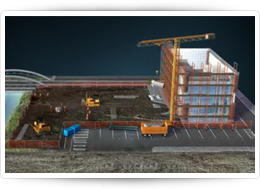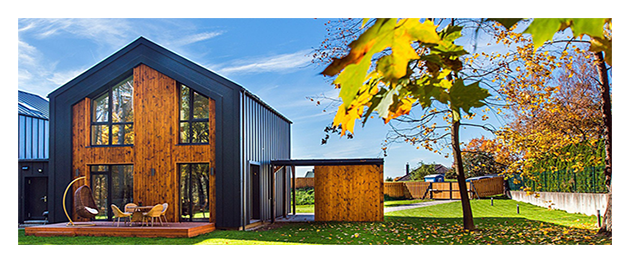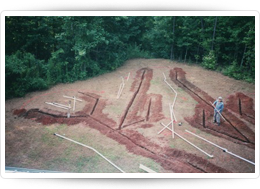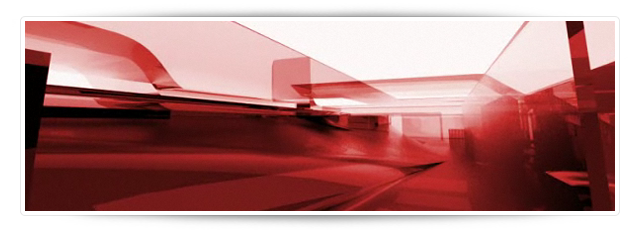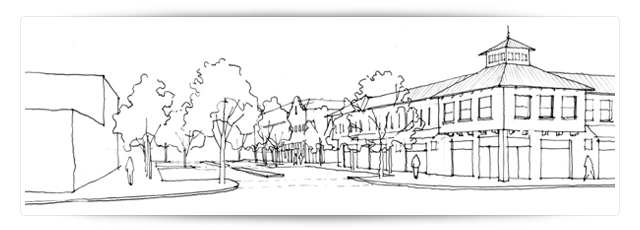
It seems fitting that we kick-off our new Neighborhood Design Blog with a discussion on form-based codes. Form-based codes have been used for centuries (e.g., the planning of cities in ancient China and Roman town planning), but were summarily dismissed in the U.S. during the turn of the century by the adoption of zoning ordinances. Considering the continual depopulation and decay of our urban neighborhoods and increased urban sprawl, is it then important that we, collectively, discuss solutions? Most recently the U.S. Green Building Council (USGBC) entered the fray by releasing the LEED for Neighborhood Development Rating System (LEED ND) that integrates the principles of smart growth, urbanism and green building into the first national system for neighborhood design.
Perhaps it may be best to analyze the information on form-based codes presented here by, first, offering arguments contesting New Urbanism. Lolita Buckner Inniss, Associate Professor of Law, Cleveland-Marshall School of Law, Cleveland State University, Cleveland, Ohio gave a presentation on October 18, 2008 at the Twelfth Annual National Conference on Private Property Rights titled The Façade of New Urbanism & the Form-Based Code. A few of her more salient talking points critiquing both New Urbanism and form-based codes:
What would describe any plan that’s form-based code would be one that’s first and foremost supposed to be “collaborative”; it’s supposed to be something between government and citizens. So if you’re looking at a plan and ask if it’s a type of form-based code, is there a collaborative piece between government and citizens? Next, it’s regulating “design” rather than “use.” And so it’s pre-scriptive rather than pro-scriptive or de-scriptive, meaning by prescriptive that it tells you exactly what you are supposed to be doing, as opposed to proscriptively telling you what you can’t do, and descriptive telling you the sorts of things you want to do.
The charette process relies on the “community” in order to sort of pull together form-based code plans. All too often it doesn’t work out as claimed. That’s a wonderful example of what happens when you claim that the community is going to be represented. All too often, form-based code plans end up representing the elites who put them together, who bring in the experts, who all too often monopolize the talk that’s going on. And it’s a wonderful way for a very, very small strand of people in the community to have their views represented as “what everybody wants.”
Also consider that people say, “Let’s have a city like we used to have.” Well, for those people who are social justice activists, and I am, I say, “Wait a minute. Traditional cities, that’s where the rich people live. They didn’t want anybody who wasn’t very wealthy to live there, and zoning was a way of helping to wall out some of their neighborhoods. How could we say that this form-based code in general is a social justice tool when what it’s based on was something that by its very nature was exclusionary?”
However, as communities are looking for solutions to help resolve their problems, many are considering form-based codes. In 2009, Phoenix, AZ prepared the Form-Based Zoning White Paper, Prepared for the Phoenix Planning Commission Downtown Subcommittee, to analyze the use of form-based codes for their downtown urban redevelopment plans:
Traditional zoning is based on the need to separate uses in a hierarchical manner. The most intensive districts (such as industrial) permit all uses while the least intensive districts permit specific uses (such as single-family residences). This cumulative approach was primarily focused on the protection of the single-family residence from the intrusion of non-residential uses. But with the great increase and concentration of population, problems have developed, and constantly are developing, which require, and will continue to require, additional restrictions in respect of the use and occupation of private lands in urban communities. These constantly developing problems have continued onward since, and the old solutions are not as applicable to accomplishing the goals that they were originally intended to address. No longer is keeping dirty, smoke belching factories away from the tenement buildings the most pressing issue for the community; today it’s handling massive population growth, pollution, traffic, transit, and other elements of sustainable community building. New solutions to these problems and a desire for more variety in housing and living options have encountered difficulty in application due to the older, “Euclidean” zoning methods. Various attempts to “band-aid” the problem include zoning overlays, design guidelines, and other regulatory schemes to alter existing codes to modern development needs.
Hence the development of form-based zoning; it takes the emphasis off of the separation of land-uses and focuses more on the way that the built environment of a specific site interacts with its surrounding components.
In 2004, Jason Todd Burdette wrote a major paper titled Form-Based Codes: A Cure for the Cancer Called Euclidean Zoning? In part, he explained:
Zoning is premised upon the segregation of land uses. Rudimentary zoning ordinances originated in New York around 1916 as a means of separating the lower class fabric markets from the upscale retailers of 5th Avenue nearby, and to reduce density. The Standard Enabling Acts of the 1920s granted governments the broad authority to enact zoning ordinances to reduce population densities in cities for the purposes of health, safety, and well being. The United States Supreme Court upheld this authority as constitutional in the landmark case of Euclid v. Ambler Realty (1926).
In the roughly eighty years since the Euclid decision, zoning has become the planning profession’s primary tool to regulate land use. While an effective policy response to issues at that time of a rapidly industrializing America, Euclidean zoning has unintentionally shaped the US landscape into a sprawling, auto-dependent society characterized by segregated communities of isolated populations.
Euclidean zoning makes it extremely difficult to mix uses. As a result, “traditional” development patterns with high-density housing, nearby commercial, and pedestrian-friendly walkways are virtually impossible to create. Many critics suggest that zoning promulgates sprawl. In short, Euclidean zoning prevents “good” urban design.
In recent years, new trends have emerged to address these problems to varying degrees of success. Form-Based Codes are one of the most recent planning innovations. With origins in the New Urbanist school of development, Form-Based Codes elevates physical design in city planning, as opposed to the “use-based” restrictions of Euclidean zoning.
In more recent times, zoning has been criticized by urban planners and scholars as a source of new social ills, including urban sprawl, the separation of homes from employment, and the rise of “car culture.” Some communities have begun to encourage development of denser, homogenized, mixed-use neighborhoods that promote walking and cycling to jobs and shopping. However, a single-family home and car are major parts of the “American Dream” for “nuclear families” (a family group consisting of a father and mother and their children, who share living quarters in one family dwelling, as opposed to “extended families” where many generations live under the same roof) and zoning laws often reflect this: in some cities, houses that do not have an attached garage are deemed “blighted” and are subject to redevelopment. Movements that disapprove of zoning, such as New Urbanism and Smart Growth, generally try to reconcile these competing demands. New Urbanists in particular try through creative urban design solutions that hark back to 1920s and 1930s practices.
Zoning has also been implicated as a primary driving factor in the rapidly accelerating unaffordability of housing in urban areas. One mechanism for this is zoning by many suburban and exurban communities for very large minimum residential lot and building sizes in order to preserve home values by excluding poorer people. This shifts the market toward more expensive homes than might ordinarily be built. According to the Manhattan Institute as much as half of the price paid for housing in some jurisdictions is directly attributable to the hidden costs of restrictive zoning regulation.
Reading Howard Blackson’s Coding for character: The architecture of community recent article posted in the New Urban Network, I was taken by sections of his commentary when trying to define the issues facing new urbanism today. Blackson’s reference to Einstein’s definition of insanity rang particularly true: “Doing the same thing over and over again and expecting different results.”
Although the pros and cons relative to form-based codes continue to be debated by opposing sides, as well they should be, the author offers his perception of the issues faced with conventional zoning regulations:
Redevelopment is just about dead. Here in California, the Governor is raiding local redevelopment coffers to balance this year’s budget. And yet, at the local level, we continue to hang onto redevelopment’s past slash-and-burn approach to generate tax revenue to keep the lights on, fill potholes, and keep pension plans funded.
Let’s be honest. Our cities are broke and redevelopment was unpredictable at best — except in causing a lot of angst among the general public. And, despite Einstein’s definition of insanity, a majority of our nation’s Planning Departments have stubbornly continued to use the same Land Use-based planning tools over and over again, expecting different outcomes. These same municipalities have also separated placemaking responsibilities: Public Works regulates streets; Park & Rec regulates civic spaces; General Services builds civic buildings; and now, with planning departments being cut across the nation, it appears Code Enforcement will be regulating private development.
Another New Urban Network article, Form Based Codes? A picture’s worth a thousand words writen by Hazel Borys, answers the question “Why Form-Based Codes?”:
The simple answer is that our passion is helping communities become more economically competitive, socially connected and environmentally sensitive and, time and time again, it’s existing single-use zoning that stands in their way. In response, form-based codes have emerged as a useful remedy, effectively legalizing community visions and serving as a bridge between their current conditions and the goals they’re trying to reach.
Ms. Borys goes on to describe, in general terms, what form-based codes are and how they work:
A form-based code (FBC) is a blueprint for places where true community, in all its complexity, can prosper.
To cities, planners, developers, and citizens, FBCs offer choice, quality of life, economic opportunity, environmental stewardship, and adaptability.
FBCs support community vision, local character, open lands conservation, transit options, and walkable mixed-use neighborhoods.
FBCs prevent wasteful sprawl development, automobile-dominated streets, empty downtowns, and a hostile public realm.
The SmartCode is a form-based, unified land development ordinance for planning and urban design. As a form-based code, it strongly addresses the physical form of building and development. Conversely, conventional codes focus mostly on use & density.
SmartCode is transect-based, fostering communities with a continuous cross-section of habitats, from rural wilderness to urban city core. The transect is divided into Transect Zones, each of complex character. This makes for diverse building types, thoroughfare types, and civic spaces.
Many of the features of transect planning cannot be reproduced without a change to municipal ordinances. For example, the transect encourages storefronts to push forward to the sidewalk, to allow window shopping, and push parking lots to the rear. In many municipalities, this design would not be permitted today under town planning bylaws. Hence, any effort to implement the principles of the transect must be accompanied by code changes (e.g., SmartCode).
What Are Transects?
“A town is saved, not more than by the righteous men in it than by the woods and swamps that surround it.” - Henry David Thoreau

A “transect” is usually seen as a continuous cross-section of natural habitats for plants and animals, ranging from shorelines to wetlands to uplands. The specific transect that the SmartCode uses is based on the human habitat, ranging from the most rural environments to the most urban environments. This transect is divided into a range of “Transect Zones,” each with its own complex character. It ensures that a community offers a full diversity of building types, thoroughfare types, and civic space types, and that each has appropriate characteristics for its location. A major feature of transect planning is that it incorporates a variety of residential and commercial spaces into a single neighborhood. A typical neighborhood would consist of a light commercial area with a bank, general store, pub, coffee shop, and apartments. Moving outwards from the center, residential density would gradually decrease starting with apartments to townhouses to fully detached houses. The central area would be a focus of transit and ideally be within walking distance from any point in the neighborhood.
The potential of the transect as an urban planning tool lies in:
Education - it is easy to understand
Coding - it can be directly translated into the familiar legal framework of Euclidean Zoning districts
Creating immersive environments. This is one where all of the elements of the human environment work together to create something that is greater than the sum of the parts. The transect contains other features: it creates a framework to control and promote growth in certain areas; it intends to increase pedestrian life, local safety, and community identity; and, it provides tools to protect and restore natural environments. a transect is a breakdown of city centre houses out to country houses.
The Transect is a powerful tool because its standards can be coordinated across many other disciplines and documents, including ITE (transportation), and LEED (environmental performance). Thus the SmartCode integrates the design protocols of a variety of specialties, including traffic engineering, public works, town planning, architecture, landscape architecture, and ecology. A transect is a cut or path through part of the environment showing a range of different habitats. Biologists and ecologists use transects to study the many symbiotic elements that contribute to habitats where certain plants and animals thrive. Human beings also thrive in different habitats. Some people prefer urban centers and would suffer in a rural place, while others thrive in the rural or sub-urban zones. Before the automobile, American development patterns were walkable, and transects within towns and city neighborhoods revealed areas that were less urban and more urban in character. This urbanism could be analyzed as natural transects are analyzed.
To systemize the analysis and coding of traditional patterns, a prototypical American rural-to-urban transect has been divided into six Transect Zones, or T-zones, for application on zoning maps. Standards were written for the first transect-based codes, eventually to become the SmartCode. This zoning system replaces conventional separated-use zoning systems that have encouraged a car-dependent culture and land-consuming sprawl. The six Transect Zones instead provide the basis for real neighborhood structure, which requires walkable streets, mixed use, transportation options, and housing diversity. The T‑zones vary by the ratio and level of intensity of their natural, built, and social components. They may be coordinated to all scales of planning, from the region through the community scale down to the individual lot and building, but the new zoning itself is applied at the community (municipal) scale. The T-zones are intended to be balanced within a neighborhood structure based on pedestrian sheds (walksheds), so that even T-3 residents may walk to different habitats, such as a main street, civic space, or agrarian land.


The graphics above illustrate the six T-Zones: T-1 Natural, T-2 Rural, T-3 Sub-Urban, T- 4 General Urban, T-5 Urban Center and T-6 Urban Core.
The Center for Applied Transect Studies (CATS) promotes understanding of the built environment as part of the natural environment, through the planning methodology of the rural-to-urban transect. CATS supports interdisciplinary research, publication, tools, and training for the design, coding, building and documentation of resilient transect-based communities.
CATS is committed to transect-based environmental and land development principles that encourage the following outcomes:
walkable, transit-connected communities
comprehensive zoning reform
context-based thoroughfare design and engineering
affordable housing and income diversity
regional, local, and individual food production
passive climatic response in building and urban design
of environmental impacts and costs of infrastructure
development and use of renewable energy technologies
repair of unsustainable sprawl patterns
What are SmartCodes?
SmartCode is a unified land development ordinance template for planning and urban design. Originally developed by Duany Plater-Zyberk & Company, this open source program is a model form-based unified land development ordinance designed to create walkable neighborhoods across the full spectrum of human settlement, from the most rural to the most urban, incorporating a transect of character and intensity within each. It folds zoning, subdivision regulations, urban design, and basic architectural standards into one compact document. Because the SmartCode enables community vision by coding specific outcomes that are desired in particular places, it is meant to be locally calibrated by professional planners, architects, and attorneys.
The SmartCode is not a building code. Building codes address life/safety issues such as fire and storm protection. Examples of building codes include the International Building Code (IBC), International Residential Code (IRC), and International Code Council (ICC) documents.
In the discussion of Smart Growth as an alternative to urban sprawl, one key aspect often overlooked is the currently prevailing system of community development codes and standards that by design, whether intentionally or not, have promoted subdivisions and strip malls. To change these community settlement patterns to allow for land conservation and to promote traditional patterns of hamlet, village, town and city, new codes are necessary. The most comprehensive example of a code designed for this purpose is the SmartCode.
The SmartCode is considered a “form-based code” because it strongly addresses the physical form of building and development. Conventional zoning codes are based primarily on use and density. They have caused systemic problems over the past sixty years by separating uses, making mixed-use and walkable neighborhoods essentially illegal. The SmartCode is also a “transect-based code”.
The SmartCode addresses development patterns at three scales of planning (thus it may replace a number of other documents):
The Sector (regional) scale
The Community scale
The Block and Building Scale
The maps shown below indicate the locations in the U.S. where SmartCodes have been adopted, as well as locations where SmartCodes are in the process of being adopted.


What Are Form-Based Codes?
Definition of a form-based code:
Form-based codes address the relationship between building facades and the public realm, the form and mass of buildings in relation to one another, and the scale and types of streets and blocks. The regulations and standards in form-based codes are presented in both words and clearly drawn diagrams and other visuals. They are keyed to a regulating plan that designates the appropriate form and scale (and therefore, character) of development, rather than only distinctions in land-use types…Ultimately, a form-based code is a tool; the quality of development outcomes depends on the quality and objectives of the community plan that a code implements.
Elements of a form-based code:
Regulating Plan: A plan or map of the regulated area designating the locations where different building form standards apply, based on clear community intentions regarding the physical character of the area being coded.
Public Space Standards: Specifications for the elements within the public realm (e.g., sidewalks, travel lanes, on-street parking, street trees, street furniture, etc.).
Building Form Standards: Regulations controlling the configuration, features, and functions of buildings that define and shape the public realm.
Administration: A clearly defined application and project review process.
Definitions: A glossary to ensure the precise use of technical terms.
Architectural Standards: Regulations controlling external architectural materials and quality.
Landscaping Standards: Regulations controlling landscape design and plant materials on private property as they impact public spaces (e.g. regulations about parking lot screening and shading, maintaining sight lines, ensuring unobstructed pedestrian movement, etc.).
Signage Standards: Regulations controlling allowable signage sizes, materials, illumination, and placement.
Environmental Resource Standards: Regulations controlling issues such as storm water drainage and infiltration, development on slopes, tree protection, solar access, etc.
Annotation: Text and illustrations explaining the intentions of specific code provisions.
How does one determine if a development regulation is a form-based code and a well-crafted one? Form-based codes generally receive affirmative answers to all of the following questions:
Is the code enforceable?
Is the code easy to use?
Will the code produce functional and vital urbanism?
Is the code’s focus primarily on regulating urban form and less on land use?
Is the code regulatory rather than advisory?
Does the code emphasize standards and parameters for form with predictable physical outcomes (build-to lines, frontage type requirements, etc.) rather than relying on numerical parameters (floor-area ratios, density, etc.) whose outcomes are impossible to predict?
Does the code require private buildings to shape public space through the use of building form standards with specific requirements for building placement?
Does the code promote and/or conserve an interconnected street network and pedestrian-scaled blocks?
Are regulations and standards keyed to specific locations on a regulating plan?
Are the diagrams in the code unambiguous, clearly labeled, and accurate in their presentation of spatial configurations?
Implementing form-based codes. How are form-based codes incorporated into a local government’s development regulations? There are three basic ways:
Mandatory codes: This is the most common adoption approach. It has the most regulatory “teeth”—compliance is required. But it is the most ambitious of the approaches, making the new code a seamless part of, or a complete replacement for, the existing zoning ordinance. The form-based code can be adopted as a new zoning district or as an overlay district.
Optional (parallel) codes: An optional or parallel form-based code serves as an alternative to, but doesn’t replace, a present zoning ordinance. Compliance is voluntary. The developer has the choice of complying with the form-based code or the zoning ordinance, but it must be one or the other. This approach makes sense when compliance with the zoning ordinance is so difficult and time consuming that most development is stymied. Thus a developer has the option of following a form-based code that will streamline and simplify his development process. But, for a local government to maintain two different sets of development regulations for one area is added work which can be significant if the area is extensive. Also depending on the area being regulated, if some developers are choosing the form-based code and others nearby are not, the possibilities for integrated place-making can be compromised.
Floating-zone codes: Floating zones are most often written to facilitate master-planned suburban communities and are called PUDs (planned unit developments). However, floating-zone codes are now being written as form-based codes to facilitate urban development. A floating-zone form-based code does not contain a regulating plan but includes instructions and standards for developers to follow when they prepare a regulating plan for their property (e.g. maximum block dimensions, street types, building types, open space accessibility, sidewalk widths.) This distinguishes floating-zone codes from the other two approaches–developers rather than the local government create the regulating plans and the urban designs that they facilitate, but the local government sets the standards. Floating-zone codes allow local governments to establish urban form standards for development without incurring the expense of developing urban design and regulating plans. Developers are given the freedom, within clear parameters, to prepare regulating plans for their property that are likely to meet government approval. A developer submits his or her regulating plan for approval through the rezoning process. Upon rezoning, the floating zone replaces the prior zoning for that property and the regulating plan becomes binding.
Available from the Form-Based Codes Institute (FBCI) is a series of informative form-based code videos. Videos & Slideshows
Summary
As previously stated, there is, as should be, debate between those who support the traditional forms of zoning and those who support form-based codes. Open and public debates can have a way of neutralizing the extremist position on both sides of an argument. Talk to those who are, or have been, actively involved and most will agree their “preferred” method of regulating community development is not without issues. Given the fact the conditions in this country that created traditional zoning have changed dramatically since the 1920s and the industrial revolution, we should look to compromise as a possible means to help resolve as many of our current problems as possible. Can Euclidean Zoning best handle population growth, pollution, traffic, transit, and other elements of a more desirable, sustainable community? Or are form-based codes better suited to this task? Or should there be compromise from both camps? As new developments are created and existing communities struggle to exist in a sustainable environment, there may be no better opportunity to reflect on our ability, as a society, to adjust. We are witnessing new green building codes being mandated across the country that understand and appropriately address our environmental concerns relative to new and existing buildings. However, in many instances, this merely places sustainable buildings in an unsustainable environment.
Additional resources:
Because they are based on the physical form of the built and natural environment, all transect-based codes are form-based codes (FBC). The SmartCode, released in 2003, is the pioneering transect-based model code. Due to the growing number of consultants advertising themselves as capable of writing FBCsbut with little or no training, in 2004 the non-profit Form-Based Codes Institute was organized to establish standards and teach best practices. In addition, SmartCode workshops are regularly scheduled by PlaceMakers, SmartCode Pro, and SmartCode Local.
Center for Applied Transect Studies (CAT)
Form-Based Codes Institute (FBCI)
SmartCode
New Urban Network
New Urban Network Codes Study Maps (google map of U.S. and international smart code locations)
The Codes Project
Planetizen
Integrated Design (ID) Charrettes
PlaceMakers
SmartCode Central
SmartCode Local
Duany Plater-Zyberk & Company (DPZ)
Property Rights Foundation of America
Form-Based Code Samples:
Arlington, VA Columbia Pike
Ft. Myers Beach, FL Land Development Code
More sample codes are available from the Form-Based Codes Institute (FBCI)
Definitions:
Zoning
Building Codes
Open Source
Urban Design
Urban Sprawl
 WARNING: Mercury vapor released from broken compact fluorescent light bulbs can exceed safe exposure levels!
WARNING: Mercury vapor released from broken compact fluorescent light bulbs can exceed safe exposure levels!


